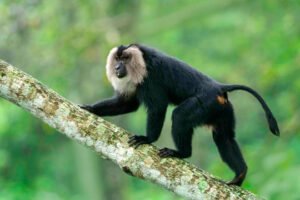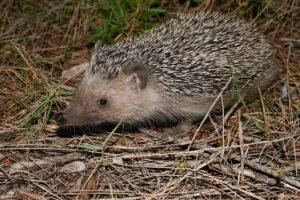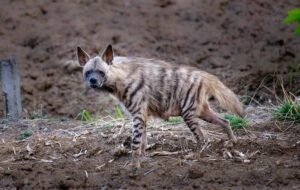Tamil Nadu Allocates ₹1 Crore for Wildlife Protection
|
General Studies Paper III: Conservation, Wildlife Protection |
Why in News?
Recently, the Tamil Nadu government allocated ₹1 crore to conserve four lesser-known endangered species, reflecting a growing focus on biodiversity protection. This step highlights the state’s commitment to safeguard fragile ecosystems and prevent species extinction.
What is Tamil Nadu’s Wildlife Protection Initiative?
- About: In a significant step toward biodiversity conservation, the Tamil Nadu government approved a fund of ₹1 crore in 2025 to safeguard four lesser-known endangered species. It focuses on species that are often overlooked but play critical roles in maintaining ecological balance.
- Target Species: The scheme targets four ecologically important species: the Lion-Tailed Macaque, Madras Hedgehog, Striped Hyena, and Hump-Headed Mahseer. Each species is essential for ecosystem functions.
- Fund Allocation: The total ₹1 crore fund is distributed based on the ecological needs of each species. ₹48.50 lakh is dedicated to the Lion-Tailed Macaque, ₹20.50 lakh for the Madras Hedgehog, ₹14 lakh for the Striped Hyena, and ₹17 lakh for the Hump-Headed Mahseer. These funds are earmarked for critical conservation measures.
- Implementation: The scheme includes a wide range of practical interventions to support the species and their habitats:
-
- Habitat Monitoring and Research: Authorities will conduct systematic population surveys and ecological assessments. Data collected will help in planning long-term conservation strategies.
- Connectivity and Breeding Initiatives: For the Lion-Tailed Macaque, canopy bridges will connect fragmented forests, allowing safe movement and genetic diversity. For the Hump-Headed Mahseer, in-situ breeding, culture, and release programs will restore riverine populations.
- Awareness and Community Engagement: Educational programs will be conducted in schools and local communities. Signages in sensitive areas will promote awareness of endangered species and encourage protective behavior.
- Frontline Staff Training: Forest department personnel will receive specialized training to handle conservation challenges efficiently. This includes strategies for monitoring populations, reducing human-wildlife conflict, and managing habitats.
About These Four Lesser-Known Endangered Species
- Lion-Tailed Macaque
- The Lion-Tailed Macaque (Macaca silenus) is a primate found only in the Western Ghats of Tamil Nadu and Kerala.
- It is classified as Endangered by the IUCN.
- These macaques are small, black monkeys with a silver mane around their face and a tufted tail that resembles a lion’s tail.
- They live in dense tropical rainforests and rarely come to the ground.
- They eat fruits, leaves, insects, and small animals, which helps in seed dispersal and maintaining forest regeneration.
- They play a key role in keeping the rainforest ecosystem balanced.
- The species faces severe threats due to habitat fragmentation, road construction, and human encroachment.
- Forest patches are shrinking, and macaques often get isolated, which affects breeding and survival.
- Madras Hedgehog
- The Madras Hedgehog (Paraechinus nudiventris) is a nocturnal mammal found in semi-arid areas of Tamil Nadu, Andhra Pradesh, and Kerala.
- Its IUCN status is Data Deficient, meaning scientific knowledge about its population is limited.
- It has a small rounded body covered with spines and moves mostly at night to avoid predators.
- Hedgehogs feed on insects, small vertebrates, and plants, which helps in controlling insect populations and maintaining soil health.
- The species faces threats from habitat destruction, pesticide use, and road accidents, which reduce survival chances.
- Protecting the Madras Hedgehog ensures the balance of semi-arid ecosystems and supports biodiversity at ground level.
- Striped Hyena
- The Striped Hyena (Hyaena hyaena) is a scavenger found in Mudumalai Tiger Reserve, parts of Rajasthan, and Gujarat. Its IUCN status is Near Threatened.
- It has a greyish body with black stripes, a strong jaw, and a bushy tail.
- The hyena primarily feeds on carrion and small animals, which makes it a natural disease regulator in ecosystems.
- By removing decaying matter, it prevents the spread of diseases to humans and other animals.
- The species is declining due to poaching, habitat loss, and human conflict, as people often kill them for fear or superstition.
- Hump-Headed Mahseer
- The Hump-Headed Mahseer (Tor remadevii) is a large freshwater fish found in the Moyar River and other rivers in the Western Ghats. It is classified as Critically Endangered by the IUCN.
- The fish is notable for its prominent hump on the head and grows to large sizes.
- It feeds on smaller fish, crustaceans, and plant matter, helping in nutrient cycling and river ecosystem health.
- The species faces serious threats from dams, overfishing, pollution, and invasive fish species, which have caused drastic population declines.
- Protecting them helps restore freshwater ecosystems and ensures the survival of a species that maintains the ecological balance of rivers in the Western Ghats.
Other Efforts to Protect Biodiversity in Tamil Nadu
- Tamil Nadu is recognized as a global biodiversity hotspot because of its rich variety of plants, animals, and ecosystems.
- The state hosts the Western and Eastern Ghats, which are home to many endemic and endangered species.
- In 2022, Tamil Nadu created the Dugong Conservation Reserve in Palk Bay to protect the rare marine mammal Dugong (Dugong dugon). Dugongs are herbivorous and their presence indicates a clean and healthy marine environment.
- The Kadavur Slender Loris Sanctuary, established in 2022, focuses on protecting the Slender Loris (Loris lydekkerianus), a small nocturnal primate. These primates live in dry forests and scrublands of Tamil Nadu. They feed on insects and small animals, helping control pest populations.
- In 2023, Tamil Nadu launched Project Nilgiri Tahr to protect the mountain goat species Nilgiri Tahr (Nilgiritragus hylocrius). These herbivores are found in the high-altitude grasslands of the Western Ghats. They help maintain grassland ecology by grazing, which supports plant diversity and soil health.
- Tamil Nadu’s integrated approach demonstrates leadership in protecting biodiversity and meeting global environmental commitments, such as the Kunming-Montreal Global Biodiversity Framework.














